The Pitbull Mastiff Mix, a cross between an American Pitbull Terrier and a Mastiff, is a unique breed. From my experience at the kennel, these dogs often get a bad rap due to their size and heritage, but the fears are usually unfounded. They’re not inherently aggressive as some might think.
Instead, I’ve found them to be lovable and friendly. There’s this one, Bruno, who’s a giant but acts more like a gentle giant. Despite being a large breed, they often act as if they’re small enough to be lap dogs — always seeking cuddles and affection.
It’s important to understand what you’re getting into with a Pitbull Mastiff Mix. They require an owner who’s ready to commit and understand their needs. But for those who are up for it, these dogs make incredibly devoted and loving companions.
In the following sections of this article, we’ll dive deeper into the world of the Pitbull Mastiff Mix. I’ll share insights from my firsthand experience with these dogs, covering everything from their temperament and exercise needs to their health and training requirements.
TABLE OF CONTENTS
- Pitbull Mastiff Mix Quick Breed Summary
- History and Origin of the Pitbull Mastiff Mix
- Physical Characteristics of the Pitbull Mastiff Mix
- Pitbull Mastiff Mix Personality and Temperament
- Common Health Concerns for Mastiff Pitbull Mix
- Caring for a Pitbull Mastiff Mix
- Pit Mastiff Mix Buyer's Guide
- FAQs on Pitbull Mastiff Mix
- Big Dogs with Big Energy
- More American Pitbull Terrier and Mastiff Mixes
Pitbull Mastiff Mix Quick Breed Summary
| Breed Mix Name: | Pitbull Mastiff Mix, Pit Mastiff, Mastiff Pit, Masti-Bull |
| Size: | 25 to 30 inches tall |
| Weight: | 100 to 140lb |
| Lifespan: | 8 – 12 years |
| Coat: | Short and firm |
| Color: | Brown, Black, White, Red Or Brindle |
| Do They Shed: | Low |
| Temperament: | Loyal, Friendly, Sweet Natured |
| Intelligence: | Highly intelligent |
| Socialization: | Not dog or pet friendly |
| Destructive Behavior: | Will chew when bored |
| People Skills: | Weary of strangers |
| Good with Children: | Great with children, best with older children |
| Activity Levels: | Activity needs can vary, but will need around 1 hour of exercise a day |
History and Origin of the Pitbull Mastiff Mix
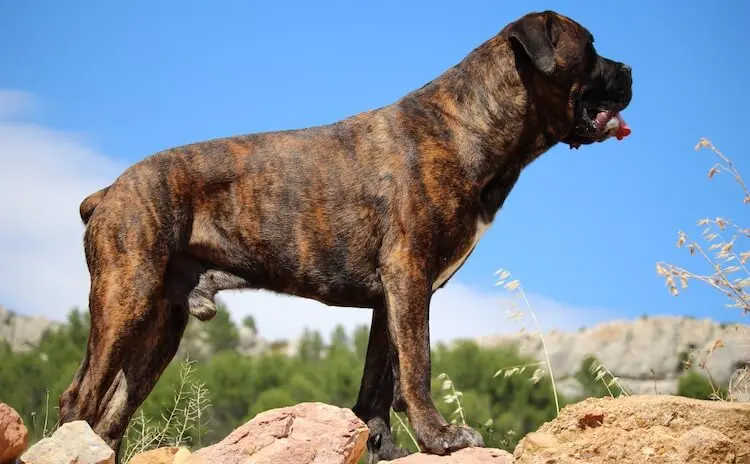
From Adobe Stock
Let’s talk about the heritage of the Pitbull Mastiff Mix. This mix can involve various Pitbull and Mastiff breeds, though the American Pitbull Terrier and the Neapolitan Mastiff are common choices. I’ve also seen mixes with American Staffordshire Terriers and Bullmastiffs.
From my experience, understanding their history is key to appreciating these dogs. Both parent breeds have a past steeped in tough roles. Pitbulls and Mastiffs were originally bred for intense and, frankly, grim activities like bear-baiting. It’s a stark contrast to the friendly and loyal companions they are today. For instance, Pitbulls, once known as ‘nanny dogs’ due to their protective nature, are now often used in scent work. Mastiffs, famed as guard dogs in England, nearly vanished after the world wars. Their comeback is a testament to the dedication of breeders, especially in the U.S., who worked tirelessly to rebuild their numbers.
It’s important to note that this crossbred dog isn’t recognized by the American Kennel Club, but the Mastiff, one of its parent breeds, is. This mix is more than just a blend of breeds; it’s a living history of transformation and resilience.
Let’s discuss the parent breeds below.
Pitbull
It’s a breed that I’ve come to know quite well through my work and one that often gets a lot of attention, not always for the right reasons.
The Pitbull, specifically the American Pitbull Terrier, originated from crossing old English Bulldogs and terriers back in England. They were initially bred for bull-baiting, a cruel sport where dogs were set to fight a bull. Thankfully, those days are long gone. After this sport was outlawed in the 19th century, the Pitbull’s ancestors were brought to America, where they became farm dogs, known for their strength and loyalty.
Physically, Pitbulls are muscular and sturdy. They have a broad head and a short, smooth coat that comes in many colors. Among these variations, the striking black Pitbull stands out. What’s remarkable about them is their strength, which is evident in their well-defined muscles. They’re medium-sized, but their build makes them look imposing.
In terms of temperament, Pitbulls are often misunderstood. Many people think they’re aggressive because of their history and muscular appearance. But working with them, I’ve seen how loving and affectionate they can be. They’re incredibly loyal to their families and can be very gentle, especially with children. Pitbulls are also known for their intelligence and eagerness to please, which makes them trainable. However, they do have a lot of energy and require regular exercise and mental stimulation.
One thing I always tell potential Pitbull owners is that socialization and training are key. These dogs need to be well-socialized from a young age to ensure they’re well-rounded adults.
Mastiff
Mastiffs are one of the oldest dog breeds, with roots tracing back to ancient civilizations like Egypt and Rome. They were initially bred for guarding and protection. Due to their large size and imposing presence, they were perfect for these roles. Throughout history, they’ve been used in wars and as estate guardians.
Speaking of size, Mastiffs are known for their massive build. They’re one of the largest dog breeds. They have a broad head, a short coat, and a generally imposing yet noble appearance. Despite their size, they move with a surprising grace.
In terms of temperament, Mastiffs are gentle giants. My experience with them has shown me that they are incredibly loyal and protective of their families. They might look intimidating, but they’re usually calm and affectionate with their owners. They are particularly good with children, often showing a patient and gentle side. Despite their protective instincts, Mastiffs are not typically aggressive.
However, due to their size, they need a living space that can accommodate them comfortably. They also require moderate exercise to keep them healthy, but they’re not as high-energy as some other breeds. Socialization is important for Mastiffs, too. Because of their protective nature, they need to learn how to interact with strangers and other animals appropriately.
One thing to note is that Mastiffs tend to be a bit laid-back, but they’re still intelligent and responsive to training. They respond well to positive reinforcement techniques.
Physical Characteristics of the Pitbull Mastiff Mix
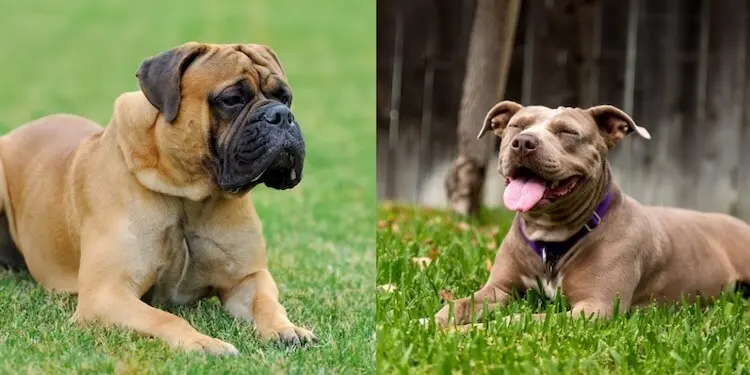
From Adobe Stock
In my time working with dogs, I’ve seen quite a variety of Pitbull Mastiff mixes. The specific Pitbull breed used, whether it’s an American Staffordshire Terrier or a Pitbull Terrier, makes a difference. Regardless of the mix, these dogs are almost always giant-sized with a muscular body that’s hard to miss. They usually have stocky builds and broad heads. Some have the squared nose typical of Mastiffs and even inherit the distinctive wrinkles around their head, eyes, and muzzle.
Height and Weight
These crossbreeds get their size mainly from the Mastiff side. It’s not unusual to see a male Mastiff Mix weighing up to 230 pounds, far more than the average 60-pound Pitbull. The weight of a Pitbull Mastiff Mix puppy depends largely on their parents’ size, but they generally grow to be between 100-140 pounds by the time they’re 18-24 months old. It’s hard to predict exactly how big they’ll get, but they lean towards the giant size, with males typically being larger than females.
Coat Color
The coat colors of a Mastiff Pitbull Mix are diverse. Hence, you can get a brown, black, white, red, or brindle Mastiff Pitbull Mix. You might even see a tri-colored mix. Many have distinctive markings on their faces similar to a Pitbull or the ‘black mask’ commonly seen in Mastiffs. These markings can also appear on their chest and feet.
Coat
From my experience, one thing you can be sure of with a Pitbull Mastiff Mix is their coat type. Both parent breeds have short, fine coats, and this trait is passed down to the mix. This makes them relatively low-maintenance when it comes to grooming.
Pitbull Mastiff Mix Personality and Temperament
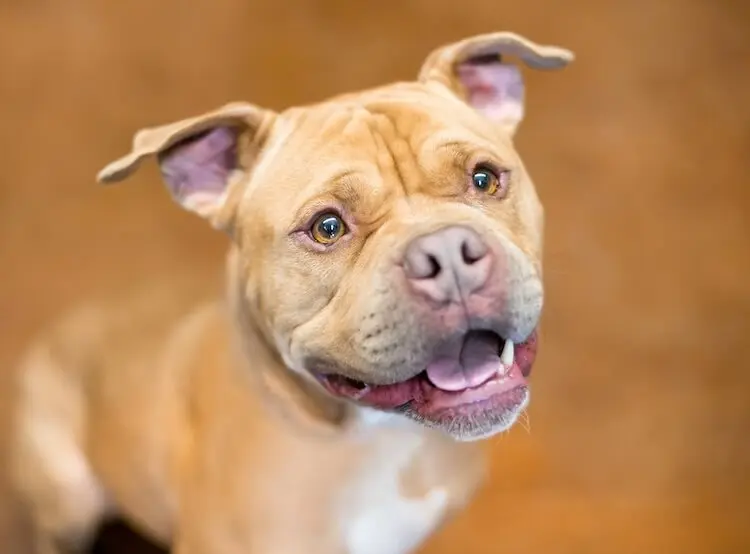
From Adobe Stock
Talking about the personality and temperament of the Pitbull Mastiff Mix, I’ve noticed they often reflect the best qualities of both parent breeds.
These dogs, like their Pitbull and Mastiff parents, are incredibly loyal. They’re affectionate companions, often surprisingly sweet-natured and friendly. I’ve seen them become the best companion dogs, thanks to their loving demeanor. Their ability to form strong bonds with their families is remarkable. But this intense loyalty can have its downsides. They can suffer from separation anxiety if left alone for too long. It’s best to avoid leaving them by themselves for more than three hours, as they might turn to chewing to cope with their anxiety.
The guarding instincts of both parent breeds are strong in this mix, making them excellent watchdogs. They’re naturally protective of their family and can be wary of strangers, sometimes appearing aloof to guests. This protective nature means they’re great for home security, but it also means they need proper training and socialization to ensure they don’t become overly protective.
Regarding their interaction with other dogs, Pitbull dogs can sometimes be standoffish. So, it’s crucial to socialize a Pitbull Mastiff Mix puppy early on. Exposing them to various environments and other dogs can help them become well-rounded and more comfortable around other pets. This early socialization is key to preventing aggressive tendencies and ensuring they become well-adjusted adult pets.
So, is a Pitbull Mastiff Mix a good family dog?
In my experience, the answer can be yes, but with some considerations.
First off, their loyalty and loving nature are undeniable. However, their size is a significant factor to consider, especially around small children. These dogs are large and even their playful actions can unintentionally be too rough for little ones.
That being said, if they are socialized and trained correctly from a young age, they’re typically gentle giants. They’re not known to be aggressive toward people, but due to their size and strength, accidents can happen. So, it’s often better for this breed to be in a home with older children who can understand and respect a dog’s boundaries.
It’s crucial to educate kids on basic dog body language. They should know when the dog needs space and when it’s okay to interact. And of course, always supervise interactions between your kids and these big dogs.
In a home with older children who understand how to behave around large dogs, a Pitbull Mastiff Mix can thrive. They love the affection and attention that a big family can provide. Just remember, like any dog, they need their space and understanding to be a happy part of the family.
Common Health Concerns for Mastiff Pitbull Mix
As a crossbreed, they are generally healthier than pure breeds, as there is more genetic diversity, decreasing risks of predispositions of disease. However, this mix can still inherit health issues from their parents, including the following:
Hip Dysplasia
Hip dysplasia is a common issue I’ve seen in larger breeds like the Pitbull Mastiff Mix. It’s a condition where the hip joint doesn’t fit together perfectly, which can lead to arthritis or lameness. It’s partly genetic, so it’s important to check the health of the puppy’s parents if possible. Symptoms include difficulty in standing up, reluctance to jump or run, and a noticeable change in the way they walk, like a bunny hop. Watching a dog struggle with hip dysplasia is tough. They might start showing signs as they grow older, so it’s something to be mindful of as your dog ages.
Elbow Dysplasia
Similar to hip dysplasia, elbow dysplasia is another joint issue that’s prevalent in larger dogs. It involves an abnormal development of the elbow joint, leading to pain and mobility issues. I’ve noticed that dogs with this condition might limp or show reluctance in using their front legs. It’s often caused by a combination of genetics, diet, and rapid growth during puppyhood. The first signs typically appear when they’re still young, sometimes as early as six months old.
Gastric Dilatation-Volvulus (Bloat)
Bloat, or Gastric Dilatation-Volvulus, is a serious condition that I’ve seen happen suddenly and can be life-threatening. It occurs when the stomach fills with gas and then twists, cutting off blood flow. Symptoms include a swollen abdomen, restlessness, drooling, and attempts to vomit without bringing anything up. Large breeds with deep chests, like the Pitbull Mastiff Mix, are more prone to it. It’s thought to be caused by eating too quickly, so feeding smaller, more frequent meals can help reduce the risk.
Heart Problems
Heart problems, including conditions like cardiomyopathy, are something I’ve come across in these mixes. These conditions affect the heart’s ability to pump blood effectively. Symptoms can include coughing, difficulty breathing, and lethargy. While some heart conditions are inherited, others can develop due to factors like diet and exercise. It’s heartbreaking to see a dog struggle with heart issues, but with proper care, many can still lead fulfilling lives.
Skin Allergies
Skin allergies are something I see quite a bit in many dogs, including the Pitbull Mastiff Mix. They can be allergic to a variety of things, from food ingredients to environmental factors like pollen. Symptoms include itching, redness, and hair loss. It’s often a process of elimination to figure out what’s causing the allergy, and it can be frustrating to see your dog so uncomfortable. Regular vet check-ups and being attentive to any changes in their skin or coat can help manage this condition.
Caring for a Pitbull Mastiff Mix
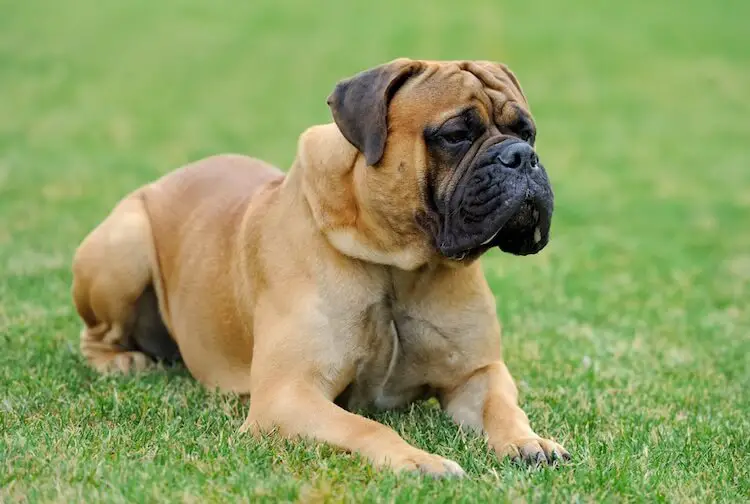
From Adobe Stock
Caring for a Pitbull Mastiff Mix is definitely a commitment, and it’s one that shouldn’t be taken lightly. I’ve seen these large, energetic dogs thrive in the right environment, but they’re not suited to every lifestyle. Below are some areas that you have to include in your pet’s care routine.
Exercise
These dogs are a mix of energy and laid-back attitudes. Pitbulls are known for their zest, while Mastiffs are more relaxed. The mix can be unpredictable – sometimes full of beans, other times more like a couch potato. You’ll often know when they need a walk because they might start getting restless or even a bit destructive. I recommend about an hour of exercise daily to keep them healthy and mentally stimulated. But, it’s funny, Mastiffs sometimes just decide they’re done with a walk and plop down, refusing to budge.
Always walk them on a leash, especially around unfamiliar dogs, as their reaction can be unpredictable. And, during their growth phase, be careful not to overexercise them. These big pups can suffer from joint problems if they’re pushed too hard too soon.
Training a Mastiff Pitbull Mix
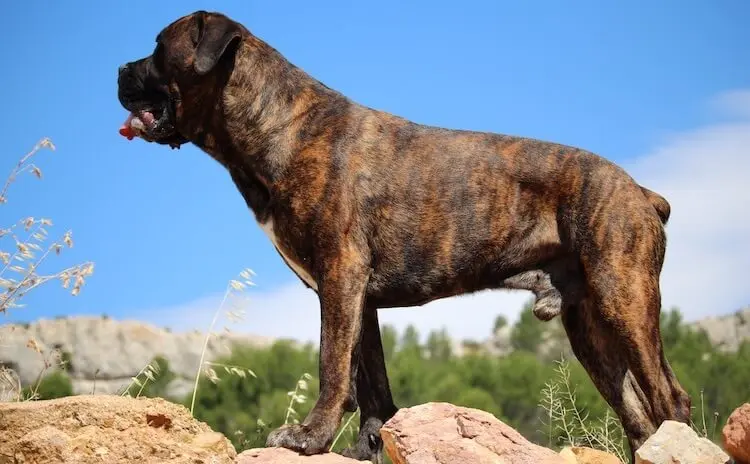
From Adobe Stock
Training these dogs can be a bit of a balancing act. They’re smart, but sometimes their Mastiff side brings a stubborn streak. Patience and consistency are key. Positive reinforcement works wonders — it’s about encouragement, not punishment. Start training early, while they’re still a manageable size. This is crucial because they grow fast!
Socialization is vital, too. Exposing them to different people, children, and dogs early on helps prevent any aggressive tendencies, especially towards other dogs. Keep training sessions short and engaging — they can lose interest quickly. To keep them from chewing on your furniture, I suggest sturdy toys that can withstand their powerful jaws. Puzzle feeders are great for mental stimulation.
Remember, training should be as fun for them as it is for you. Play not only improves their memory but also relieves stress — for both of you!
Grooming
Grooming a Pitbull Mastiff Mix is pretty straightforward, but it’s important to keep up with it to ensure your dog stays healthy and comfortable. Do the following:
Brushing
These dogs have short coats, so they don’t require as much brushing as some other breeds. However, regular brushing is still important. I recommend brushing them once or twice a week. This helps to remove loose hair and distribute natural skin oils, keeping their coat shiny and healthy. Use a firm-bristled brush; it works well with their coat type. During shedding seasons, you might need to brush them more frequently to manage the extra hair. Brushing is also a great bonding activity and can be quite relaxing for both you and your dog.
Bathing
When it comes to bathing, Pitbull Mastiff mixes don’t need to be bathed too often. Over-bathing can strip their coat of essential oils. I usually advise bathing them every two to three months, or when they get particularly dirty or start to smell. Use a mild dog shampoo to keep their skin from getting dry and irritated. Make sure to rinse thoroughly to remove all the shampoo, as any residue can cause skin irritation.
Nail Trimming
Nail trimming is an essential part of grooming. If their nails get too long, it can cause discomfort or even lead to problems walking. I’ve found that trimming their nails every month or so works well. If you can hear their nails clicking on the floor, it’s a good sign that it’s time for a trim. Some dogs don’t like nail trimming, so it may take some time and patience to get them used to it. If you’re not comfortable doing it yourself, a professional groomer or vet can do it for you.
Ear Cleaning
Regular ear cleaning is important to prevent infections, especially since these dogs can have floppy ears. Clean their ears gently with a cotton ball and a vet-approved ear cleaner. Avoid going too deep into the ear canal. Doing this once a month or when you notice their ears are dirty can help keep their ears healthy.
Dental Care
Dental care is often overlooked but it’s crucial for their overall health. Brushing their teeth a few times a week with dog-specific toothpaste can help prevent dental problems. If brushing their teeth is challenging, dental chews and toys can also help keep their teeth clean. Regular dental check-ups with the vet are also a good idea to catch any issues early.
Feeding a Pit Mastiff
Feeding a Pitbull Mastiff Mix properly is crucial for their health and well-being. Here’s a comprehensive guide covering everything from portion control to feeding schedules and treats.
Portion Control
Portion control is essential, especially for a breed this size. Overfeeding can lead to obesity, which is particularly harmful for large breeds. From my experience, the amount of food depends on their age, size, and activity level. Typically, an adult Pitbull Mastiff Mix might need about 4-5 cups of high-quality dry dog food divided into two meals per day. For puppies, they require more frequent feedings — about three to four times a day — with a puppy-specific formula that supports their growth. Always refer to the feeding guidelines on the dog food package and consult your vet to determine the right portion size for your dog’s specific needs.
Feeding Schedule
Having a consistent feeding schedule helps regulate your dog’s digestion and keeps them in a routine. I usually recommend feeding adult dogs twice a day — once in the morning and once in the evening. Puppies, on the other hand, should be fed three to four times a day due to their higher energy needs. Stick to the schedule as closely as possible. Consistency is key in preventing issues like overeating or digestive problems.
Frequency and Type of Food
The frequency and type of food are vital in maintaining your dog’s health. Puppies should be fed a high-quality puppy formula that caters to large breeds. As they grow, transitioning them to adult dog food around the age of 18-24 months is crucial. Choose a food that is appropriate for large breeds, focusing on a balance of protein, fat, and carbohydrates. Avoid foods with filler ingredients and too many additives. High-quality, nutrient-dense food might be more expensive, but it’s worth it for your dog’s health.
Treats
Treats are great for training and bonding, but moderation is key. Treats should only make up about 10% of your dog’s daily calorie intake. Choose healthy options like small pieces of cooked meat, fruits, or vegetables. Avoid human food that can be harmful to dogs, like chocolate, grapes, or onions. Always check with your vet before introducing a new treat, especially if your dog has food sensitivities.
Pit Mastiff Mix Buyer’s Guide
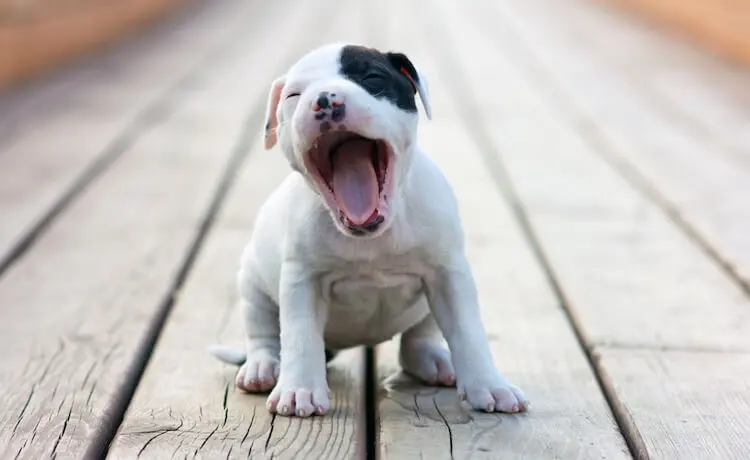
From Adobe Stock
Deciding on a Pitbull Mastiff Mix is a big step, and finding the right breeder is crucial. In my experience, locating a reputable breeder for a hybrid like this can be a bit tricky, but it’s worth the extra effort.
When a puppy catches your eye, it’s important to visit the breeder and see the puppy with its mom and littermates. If a breeder hesitates to let you meet the mom, it’s a red flag in my book. Seeing the mother dog is key, not just for health reasons, but also because her behavior greatly influences her puppies. Puppies that receive proper care from their mother tend to be better behaved and socialized. Low maternal care can lead to a host of behavioral issues.
During your visit, don’t hesitate to ask the breeder questions. I always inquire about the puppies’ diet, their socialization experiences, and the mother’s litter history. A good breeder should be transparent and willing to share this information.
Remember, a responsible breeder will be just as curious about you. They’ll want to ensure their puppies are going to a good home, so be prepared for questions about your lifestyle and experience with large breeds.
Health certifications are also vital. The breeder should provide health clearances, especially for hip and elbow scores, to show that the parents are free from genetic conditions that could be passed to the puppies. It’s particularly important for large breeds prone to hip dysplasia.
Finally, puppies should be at least 8 weeks old before they leave their mother. This time is crucial for their development and socialization.
How Much Do Pitbull Mastiff Mixes Cost?
These crossbreeds can cost from $350 to USD 2,000. The more expensive puppies should be from breeders who have a pedigree purebred parent (i.e. Mastiff) with full health screens.
FAQs on Pitbull Mastiff Mix
How long do Pitbull Mastiff mixes live?
They will live for around 8-10 years providing they are given the right exercise, diet, and love.
How big does a Pitbull Mastiff Mix get?
Pitbull Mastiff mixes are typically quite large, given their parentage. They can weigh anywhere from 100 to 140 pounds or more, depending on their specific genetic makeup. They’re generally considered to be giant-sized dogs.
Are Pitbull Mastiff mixes good family dogs?
Yes, Pitbull Mastiff mixes can be great family dogs if they are properly trained and socialized. They are known for their loyalty and protective instincts. However, due to their size and strength, they are better suited for families with older children. It’s important to teach children how to interact safely with large dogs.
What are common health concerns for Pitbull Mastiff mixes?
Common health concerns include hip and elbow dysplasia, gastric torsion (bloat), heart problems, and skin allergies. Regular veterinary check-ups and a healthy lifestyle can help manage and prevent some of these issues.
How much exercise does a Pitbull Mastiff Mix need?
Pitbull Mastiff mixes need a moderate amount of exercise. About an hour of physical activity per day is usually sufficient. It’s important to balance exercise with rest, especially during their growth phase, to avoid joint problems.
How should I train my Pitbull Mastiff Mix?
Training should start early and be consistent. These dogs respond well to positive reinforcement techniques. They can be strong-willed, so it’s important to establish yourself as a confident, consistent leader. Socialization is also key to helping them become well-rounded dogs.
What kind of grooming does a Pitbull Mastiff Mix require?
Their grooming needs are relatively low maintenance. They have short coats that require regular brushing, about once or twice a week. Bathing can be done every few months, or as needed. Regular nail trimming, ear cleaning, and dental care are also important for their overall health.
Big Dogs with Big Energy
Reflecting on my time with Bruno, the Pitbull Mastiff Mix at our kennel, I can confidently say this large crossbreed is ideal for active families, particularly those with older children. These dogs thrive in a spacious environment, like a house with a backyard where they can expend their energy. However, like many Pitbull Mastiff mixes, Bruno wasn’t too fond of unfamiliar dogs and other pets because this breed can exhibit dominant and strong-willed traits, which calls for a firm, consistent training approach.
These dogs have a high energy level and need plenty of exercise daily. If not, they might turn to destructive behaviors as an outlet. I remember how Bruno would become restless and a bit mischievous if he missed his regular playtime.
Grooming them is more straightforward than you might think. Their short coats require only occasional brushing. This simplicity in grooming is a nice balance to their need for frequent exercise. Lastly, don’t let the Pitbull’s undeserved reputation deter you. With proper socialization and training, the Pitbull Mastiff Mix can be one of the friendliest and most loyal companions.
More American Pitbull Terrier and Mastiff Mixes
Want an American Pitbull Terrier Mix or Mastiff Mix but aren’t keen on the Pitbull Mastiff Mix? Check out these other hybrid dog breeds:
American Pitbull Terrier Mixes
- German Shepherd Pitbull Mix
- Golden Retriever Pitbull Mix
- Pitbull Boxer Mix
- Pitbull Lab Mix
- Rottweiler Pitbull Mix
- Pitbull Corgi Mix
- Pitbull Husky Mix
- Pitbull Dachshund Mix



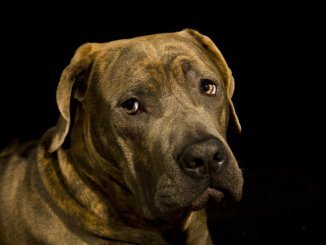
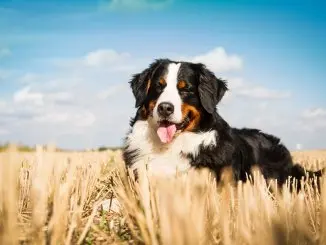
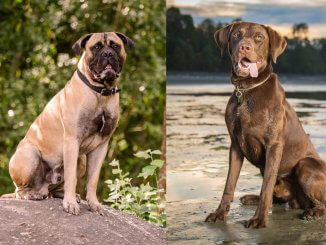
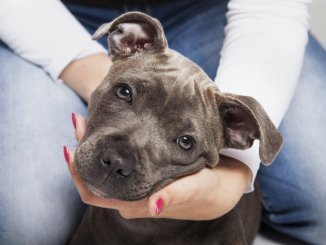
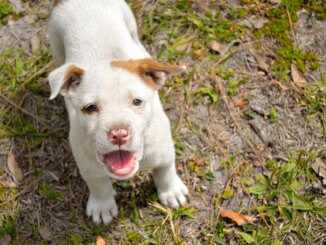
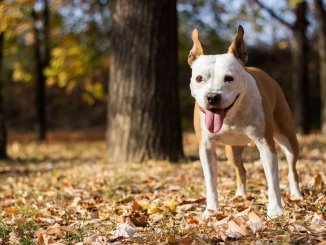
I have a beautiful pitmastiff awesome boy very loveable
I have a Mastiff Pit-bull and I wouldn’t trade him for nothing in this world. He’s very well train, he’s destructive but only of the toys I give him, nothing last for over 2mins. He’s huge, about 120lbs.
This article was really informative and helpful, thanks.
Please I don’t have ready access to a trainer, my pup is four months old, super energetic and quite destructive already but she is everything to me! How do I go about training her please? I’m not sure I can do it all by myself or that I’d know what to do.
I have 4 female Pitbull Mastiffs and they all have different personalities but are all very loyal and very loving. We love them so much!
my puppy Nibs is the sweetest, hes a big momma’s boy and a sucker for his dad. This month he’s turning 7 months, and the potty training is almost 100%. Nibs loves to chew his toys, loves swimming, chasing ducks (wont get close) and hump his teddy bear lol…
Our Baby is the best thing to happen to us.
He loves everyone, plays well with other dogs and children… loves to give kisses and whines lightly when excited, sounds adorable. Nibs is about 60-70 lbs and still growing.
I’m looking for a bullmastiff she can be 3 to 4 months old can be bred with anything for puppy.
Or if you are looking to get rid of the mother I would be interested in her as well.
I have an idea for a sled dog to run the Iditarod. And I want to start out with a bullmastiff mix then I will be breeding her puppies to the next animal and those puppies to the next animal then the final breeding will be with a Siberian husky. And that will be my sled dog team to run Iditarod.
My 120 pd blue nose pit mastiff is 9 years old and still runs around like a puppy. This article is absolutely bullshit! Do your research. People who look up, “how long does this bread live” are mostlikely trying to understand their most beloved baby’s life term. Shame on you. Smh
Thank you for speaking up ,, I also have Blue nose pit mastiff and he is the sweetest dog on the planet fiercely loyal and protective. We decided to check his he would protect us so husband poked me and lightly hog my arm and In a jiffy the dog got between us so my husband couldn’t get to me but he did not nibble or bite and I was so thankful !
We adopted him from a local shelter !
So happens that the month of October for some reason is a free adoption month( I didn’t know that ) but went there just to look at the dogs I had lost mine 4 months prior and swore never another dog it plain and simple is too hard to loose them , long story short he was adopted twice and RETURNED TWICE ??just makes my blood boil,,,when I heard that and after talking to the pound girl I decided to take him home. I fell in love with him immediately husband was iffy about this BUT they are almost inseparable !
He just loves to be with us we and we did notice that about a year after WE adopted him HE finally completely adopted us !
we will do everything in our power to feed him the best and make sure he always has the best of the best so that he will have a long happy life ,, frankly we can’t figure out how ANYONE could let a dog like him go he was found as a stray and he was chipped so he definitely was someone’s pet !!
So thank you all that go to the shelter and adopt these wonderful loyal dogs we need to find a way for people to understand that these dogs are amazing companions as for the rest of the close minded folks shame on you ,in the real world that would be considered being a racist !!
Selma V
Very true. I had a Spanish mastiff whose projected life span was seven years. He just passed away at fourteen years. We just got two bull mastiff puppies for our twenty five acres. We already have one elderly pit dalmatian who loves animals and people, a black lab, a terrier mix, five cats, goats, rabbits and chickens. The puppies are hitting it off with everyone. And they’re super interested in meeting people. We’re taking them to town regularly while still small.
My mastiff pitbull is almost 2 years old now. Everything in this article is so true about him. He is the best dog ever! We spoil him to death because we love him so much! He gets the best of everything he needs! Thank you so much for opening my eyes to the why of the way he is. He has made our lives complete!
I just bought a pit mastiff he’s 5 weeks and I want to start training him but I’m not sure when I should start or where to even begin anyone know any good trainers?
We had French massive the female tequila had two litters when she turned two years only had 3 pups.we lived on a farm we had other dogs! She got lots of exercise they would run & play. Before she turned 8 she got really sick;( and died they said that some purebreds don’t make it pass 8 she almost made it !
The male French massif same thing died just before he was going to turn 8 he was such a teddy bear so big sad
Then are purebred malemute huskie he made it till 10 he had cushion disease & that was sad watching him suffer we put him down but we were told the medication might make him feel better but nope :(